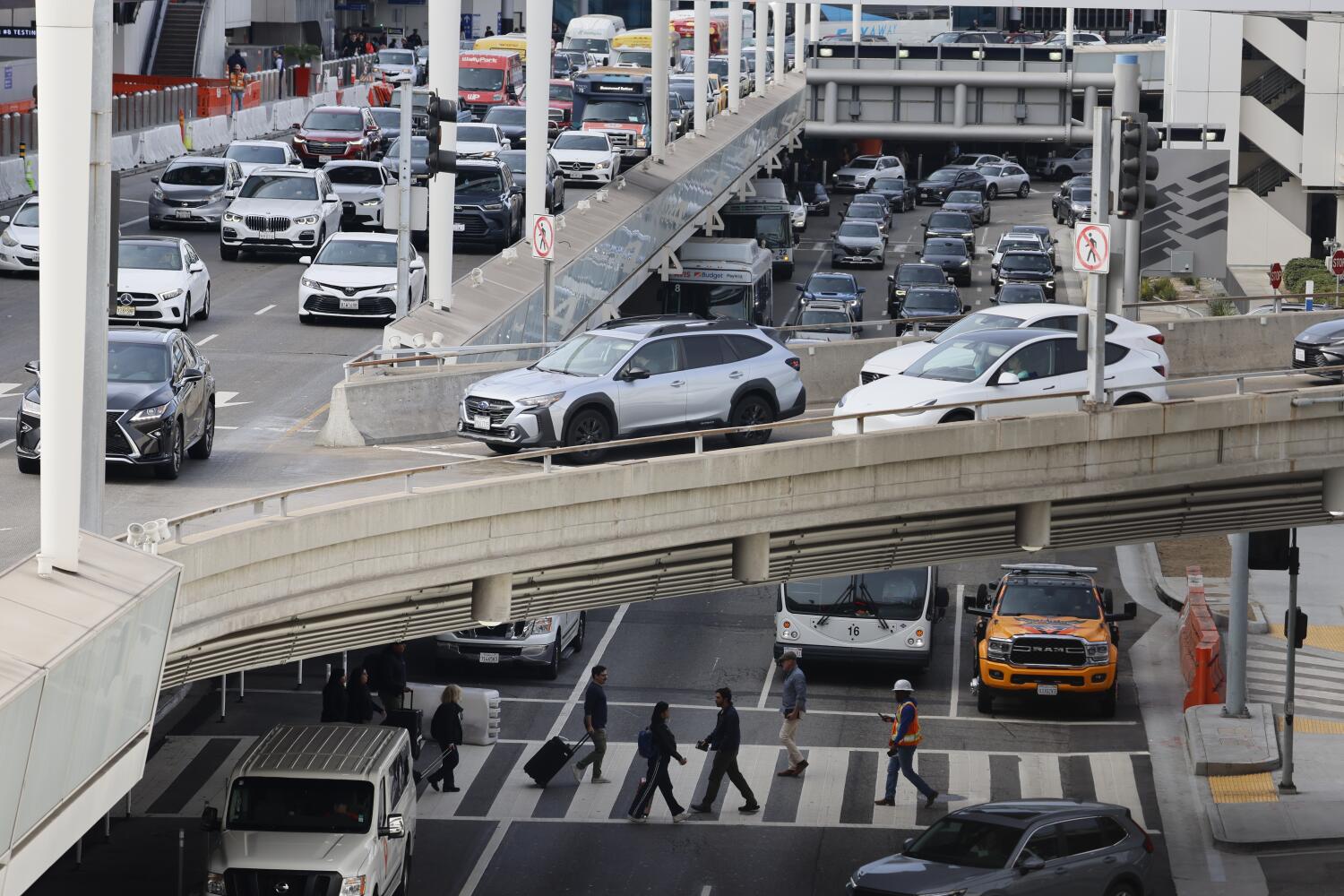-
North Korea Unveils the Completed Hull of What It Calls a Nuclear Submarine - 42 mins ago
-
San Diego man killed by falling tree in third storm-related death - 46 mins ago
-
Mike McCarthy Doesn’t Hold Back About Steelers With Playoffs Looming - 56 mins ago
-
Why China, a One-Party State, Is Backing Elections in This Country - about 1 hour ago
-
Aaron Rodgers Urges NFL to Make Big Change After DK Metcalf Incident - 2 hours ago
-
A Million More Epstein Documents Have Been Found, Justice Dept. Says - 2 hours ago
-
Peng Peiyun, 95, Dies; Official Renounced China’s One-Child Policy - 3 hours ago
-
Woman rescued after she is swept nine miles in San Jose Creek during SoCal storm - 4 hours ago
-
Former Broadway Child Actress, 25, Killed in New Jersey Stabbing - 4 hours ago
-
The Epstein File Drop Is Not About Justice - 4 hours ago
LAX approved $1.5 billion to relieve traffic. Opponents say it won’t work.

The countdown to the 2028 Olympic and Paralympic Games has sent Los Angeles International Airport into a $1.5-billion sprint to rebuild its roads, drawing ire from critics who argue the plan leaves the airport’s most infamous bottleneck — the “horseshoe” — largely untouched.
Los Angeles World Airports Board of Airport Commissioners on Thursday approved the final $1-billion phase of spending for its new roadway improvement plan, which aims to streamline traffic flow at airport entrances and exits and reduce jams on public roads like Sepulveda and Century boulevards. It’s set to be complete just two months before the world arrives in 2028.
Opponents assert the effort will not relieve airport traffic, and could even make it worse.
LAWA officials, however, said it’ll make getting to the airport safer and separate airport travelers from everyone else on the road more efficiently.
“The ATMP Roadway project is one of the most significant investments made to improve traffic in and around LAX,” Board President Karim Webb said in a statement.
Project designers promise smoother travel on the elevated segments to and from the U-shaped roadway around the terminal area commonly called the horseshoe. They said traffic in the loop itself will “roughly remain the same,” but expect entering and exiting will be far easier.
With the final funds allocated this week to Skanska-Flatiron Joint Venture, the project’s design-builder, the 4.4-mile reconfiguration aims to remove more than 500 cars from Sepulveda Boulevard at any given time, loading them into a new queue en route to the horseshoe. It also should make pedestrian crossing safer and reduce time spent at stoplights.
Airport officials said the new system will reroute drivers around airport hotels instead of funneling them onto the skyway ramp. Currently, traffic from Lincoln and Sepulveda boulevards squeezes eight lanes of cars into a single ramp, creating a persistent choke point. To ease that pressure, the agency has carved into its right-of-way to create two new off-ramps for airport access and three “through lanes” that will allow uninterrupted travel toward Imperial Highway and the 105 Freeway.
Jacob Wasserman, who manages research at the UCLA Institute of Transportation Studies, warns the traffic nirvana won’t last.
“Initially, these changes could alleviate traffic in the area and on the freeways to some degree, but it’s going to fill up again,” he said. “We all have Google Maps. When there’s less traffic, more cars will naturally file in and it’ll fill up. It’s going to move more people in total, but it’s not going to fix traffic.”
He’s talking about “induced demand,” a phenomenon in which building more roads or expanding existing ones leads to an increase in the volume of traffic, often causing congestion to return to its previous state or worsen over time.
Wasserman called the skyway remodel a “zombie project,” left over from a paused terminal expansion that included plans for two new concourses, “still moving forward on its own inertia.”
But that terminal expansion plan has been paused because of lulls in demand. Prepandemic projections anticipated more than 100 million yearly visitors to LAX in the years to come. But last year the airport had just 77 million travelers, 12% lower than its 2019 high.
The concourse projects are on hold and moving forward on them will depend on future demand, a LAWA spokesperson said.
Other concerns include a tight deadline for the roadway’s first phase. It’s set to be completed two months ahead of the 2028 Olympic and Paralympic Games. Worse still, said transit advocate and Streets for All founder Michael Schneider, LAWA is relying on FlatironDragados, a civil infrastructure contractor involved in the delayed Automated People Mover (APM) shuttle project.
“They’re pushing this through aggressively with the same contractor that screwed up the people mover,” Schneider said. “We’re expecting that this tight time frame is going to happen by the Olympics. It’s kind of a joke.”
Both the roadway improvement plan and the Automated People Mover are part of LAWA’s $30-billion Capital Improvement Program, which also includes the full demolition and modernization of Terminal 5, additional gates and new rental car and police facilities.
Once set for a 2023 opening date, the People Mover is now slated for June 2026.
This time things will be different, LAWA officials say. Phase 1 building permits are secured for the roadway project and design is 90% complete.
“We’re in a good place where, different from the people mover, we have a contract and schedule agreements in place before we really start construction,” a LAWA spokesperson said. “That’s a big difference. We’ve really learned our lessons from the APM, and we’re in a good spot because of it.”
LAWA expects the Phase 1 inbound roads to open before the 2028 Olympics without a hiccup, with the second phase outbound routes operational by 2030.
Schneider said L.A. could achieve more meaningful results with far cheaper investments.
“Imagine if the FlyAway became all-electric shuttles with Wi-Fi on board. And imagine if it was made free to 20 additional locations across L.A. County,” he said. “That wouldn’t cost anywhere near $1.5 billion.”
Local residents, led by vocal Westchester resident Cord Thomas, organized opposition to the roadway. He said he doesn’t expect his efforts to slow the renovation.
“The board unanimously supports this project … so it’s pretty clear we may not be able to move this needle,” he said.
Instead, he wants to push LAWA to rethink key design elements — especially a pedestrian bridge he believes is unsafe for people walking, biking or using scooters — and for residents to be more informed and engaged.
The spending approved Thursday covers the rebuilt roadways, new bridges and retaining walls, drainage and utility work, landscaping, lighting, and wayfinding systems.
LAWA noted that the roadway overhaul followed years of outreach, with more than 150 stakeholder meetings and multiple environmental hearings and supporters from neighborhood and business groups from Westchester, Playa Del Rey, Inglewood and El Segundo.
Source link











